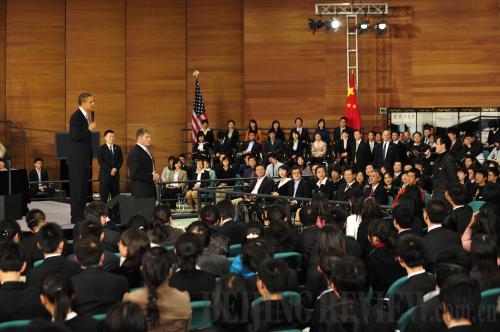|
 |
|
FACE TO FACE: U.S. President Barack Obama listens during a question-and-answer session with Chinese college students at the Shanghai Science and Technology Museum on November 16 (PEI XIN) |
Barack Obama has been a hit in China. Apart from holding talks with Chinese leaders, the 44th president of the United States impressed the Chinese with a lively question-and-answer session with college students and tours to symbolic sites such as the Great Wall. In fact, he is the first U.S. president to visit China inside his first year in office.
"The United States insists we do not seek to contain China's rise," he told Chinese students in Shanghai. "On the contrary, we welcome China as a strong and prosperous and successful member of the community of nations."
The U.S.-China relationship has opened the door to partnerships on major global concerns including economic recovery, clean energy, nuclear non-proliferation, climate change, and the promotion of peace and security in Asia and beyond, he added.
Indeed, given these pressing issues, China and the United States have increasingly found their future linked together. They discovered that the largest developing nation and the most powerful industrialized country have to work in concert.
Obama's visit to China on November 15-18 highlighted the complexity of arguably the most important bilateral relationship in the world. Moreover, for all their differences and disagreements, according to Chinese analysts, Beijing and Washington are determined to manage their relations in a way that not only is mutually beneficial but also contributes to world peace and development.
A new era
China and the United States have come up with a new vision for their relationship after years of engagement, said Yang Mingjie, a research fellow at the China Institutes of Contemporary International Relations (CICIR). In the China-U.S. joint statement issued during Obama's visit, the two nations reaffirmed their commitment to building a "positive, cooperative and comprehensive" relationship for the 21st century.
The statement added that Beijing and Washington will continue to "steadily build a partnership to address common challenges."
The two countries have made "strategic changes" in their attitudes toward each other over the past years, Yang said.
And while China shows greater tolerance toward U.S. presence in the Asia Pacific region and its contributions to international affairs, the United States also expects China to play a bigger role in the international arena, he said.
In contrast to the neither-friend-nor-foe relationship that some scholars and officials proposed after the end of the Cold War, the China-U.S. partnership defined in the joint statement is aimed squarely at their common challenges, he said.
In the context of globalization, the two countries have reached a consensus with which they need to address challenges in political, economic and non-traditional security fields.
Yang believes the joint statement is a significant document in the 30-year history of China-U.S. diplomatic relations.
| 